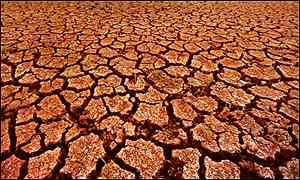|
The Sahel Desert drought, which began in the late 1960s and lasted until the early 1980s, was the worst drought of the 20th century.
 Causes
A massive drought that struck parts of Northern Africa in the 1970s and 80s may have been the result of a natural climate cycle.
Up to now, many scientists thought the drought in the Sahel zone was caused by humans over-using natural resources in the region.
But a new study in the journal Science shows how a combination of ocean temperature and loss of natural vegetation could have been the sole reasons for the drought.
The drought pushed the Sahara desert south, destroying farmland. It had a major impact on many countries including Nigeria, Niger and Mali.
Now, scientists from the Nasa Goddard Space Flight Centre and the University of California in Los Angeles believe it could all be explained by natural phenomena.
Computer simulation
The researchers produced a computer model that included ocean surface temperature, the amount of moisture in the soil, and loss of vegetation.
With all those conditions, the computer model behaved just like the Sahel drought - producing a long period of dry, cool weather.
It appears that human activity might not have been to blame for the drought, and the study suggests the Sahel region may be naturally prone to such large climate changes.
The challenge now is whether that information will help scientists predict when the next drought is likely to occur.
Effects
The Sahel witnessed some of its most serious climate induced food shortages in 1972-'74 and 1984-'85. Up to 250,000 drought-related human fatalities occurred throughout the Sahel region between 1968 and 1973. The rain shortage has killed many of the crops and left people with very bad harvests and so the food has had to be rationed. People have had to travel up to 4km to find the nearest watering hole, the lack of water is killing off the animals which they have to use to get food and money by selling them. The lack of vegetation has meant the animals have had to eat the leaves from the trees. These leave the ground with no shade and so all of the vegetation underneath die of. The trees also slowly die off, these trees usually retain some moisture so with out them the ground is drying up even quicker. The soil is then left open to the wind, the wind blows the top soil away and creates desert, when it eventually does rain the top soil is just washed away. The soil that is left behind is worked for the crops that it can produce, the only problem is that the soil eventually becomes over worked and turns into desert. The whole place is slowly becoming a desert, this is often known as DESERTIFICATION.
Solutions
There are no real solutions to the problem of drought, it occurs all over the world. There are though many things that can be done to help peope get through a period of drought. Here are but a few:
Dams - If dams were built in Sahel, this could collect any water that came. All of the local people would have to get together and collect as many stones as possible. These stones would then be made into a low wall/dam. As it rains the soil will not just be washed away and a pool of water should collect. This water will then be able to water the crops that are able to grow in the top soil that has not been washed away by the rain. This will eventually reduce the effect of the drought.
Water Pumps - With aid from other countries money could be raised to fit water pumps into villages. Under the ground is fresh clean water, with the money raised a pump could be put in and the people will have fresh clean water to wash, drink and use to water there crops.
Money - Money could be raised by selling food. If the people were helped to grow food then they could set up a business. The people would work together to grow the food, once grown they could set up a business and sell there food to raise money to help the villages. The money could help them to live there lives.
These are but only a few of the ways they can be helped!
|

